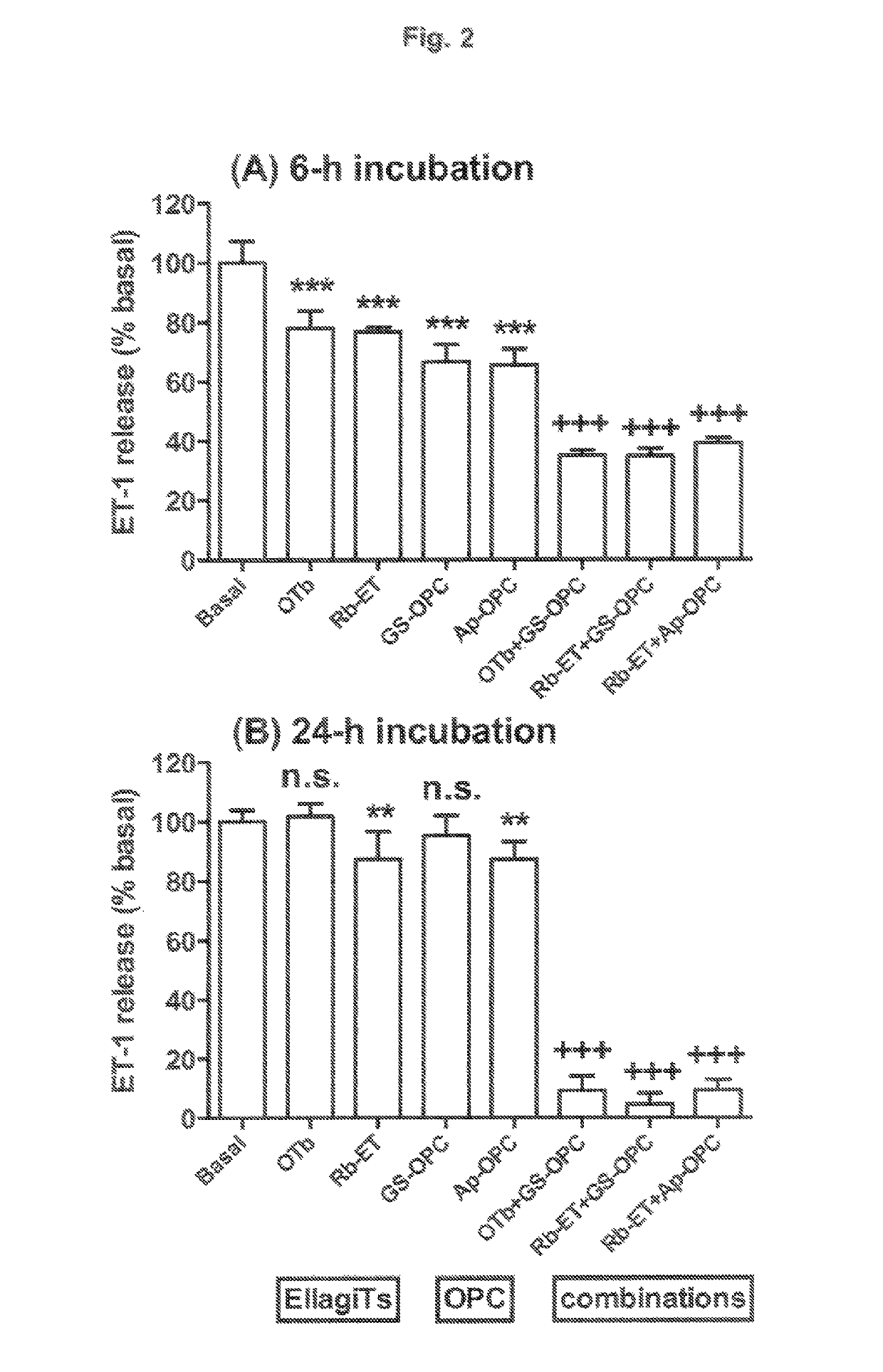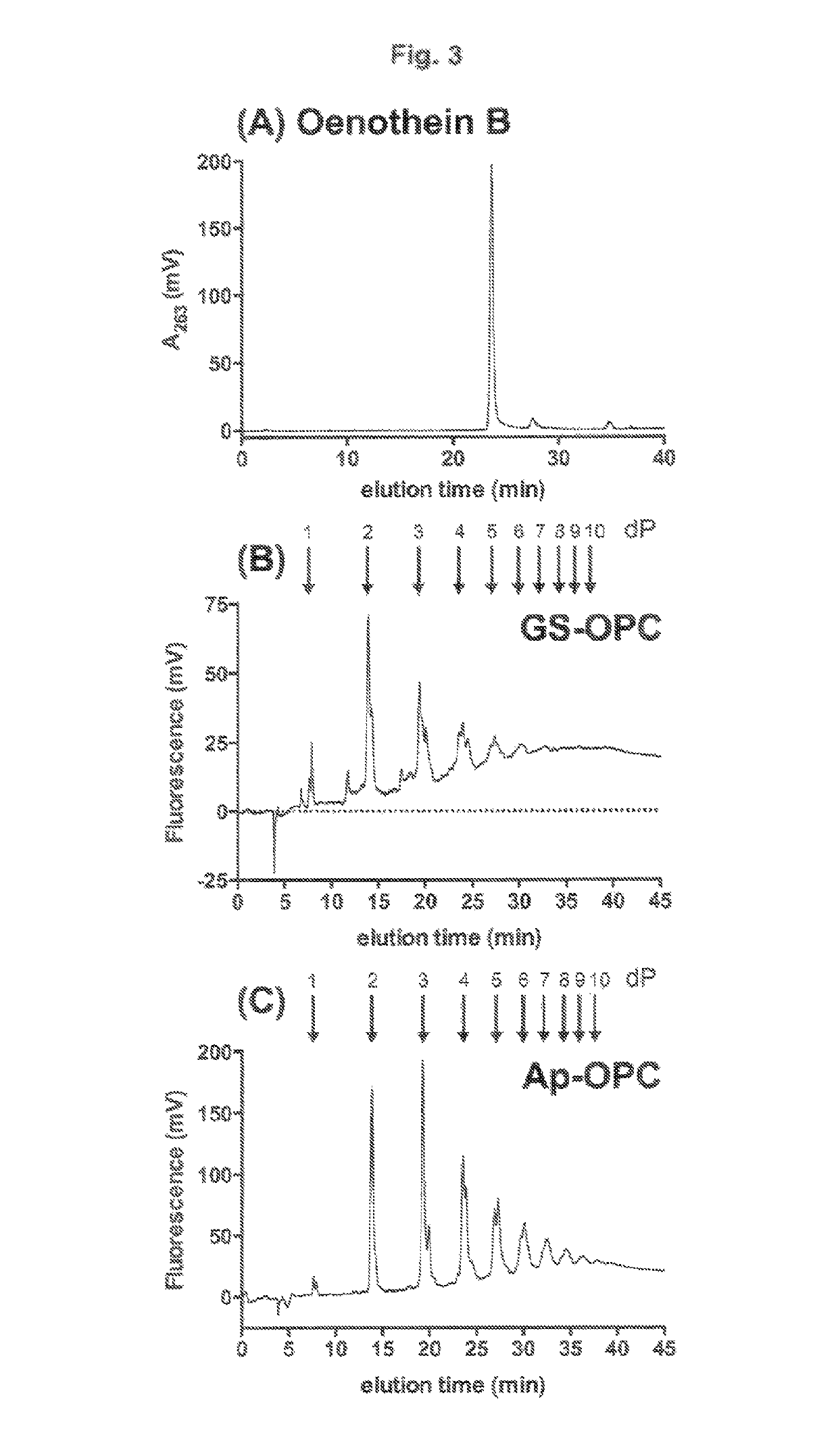Method of treating endothelial dysfunction with oenothein B and proanthocyanidins
a technology of endothelial dysfunction and proanthocyanidins, which is applied in the field of treating endothelial dysfunction with oenothein b and proanthocyanidins, can solve the problems of no pharmaceutical medications specifically treating endothelial dysfunction, increased mortality risk of patients with chronic heart failure, and endothelial dysfunction. , to achieve the effect of preventing or treating endothelial dysfunction
- Summary
- Abstract
- Description
- Claims
- Application Information
AI Technical Summary
Benefits of technology
Problems solved by technology
Method used
Image
Examples
example 1
n and Partial Purification of Raspberry Ellagitannins
[0147]Aqueous acetone (70% in water), 3 l, is added to fresh seeds of red raspberries (approx. 2 kg) in a 5 l polypropylene beaker and mixed for 1 h at room temperature with a magnetic stirrer. The crude seed extract is filtered through a porous PTFE filter to separate the raspberry polyphenol extract (approx. 2.5 l) from particulate material. The resultant solution of raspberry polyphenols is diluted with 10 mM acetic acid (7.5 l) and pumped onto a column of Sephadex® LH20 (5×15 cm), which has been pre-equilibrated with 10% acetone in 10 mM acetic acid. The column is rinsed by pumping through 1 l of 10 mM acetic acid, followed by 1 l of 20% acetone in 10 mM acetic acid. Elution of raspberry ellagitannins is achieved by pumping 2 l 50% acetone in water. Fractions (200 ml) are collected. Fractions are monitored for polyphenol content by UV absorption measurements at 280 nm, and colorimetric assay measurements of polyphenols using F...
example 2
fication of Fractions from Adsorption Chromatography
[0149]Peak fractions eluted with 50% aqueous acetone from Sephadex® LH20 are concentrated under vacuum to remove acetone. The concentrated extract is pumped onto a column of C18 silica (5×25 cm) at a flow rate of 50 ml / min. The column is rinsed with 1 liter of 8% methanol, and then eluted with 1.5 liter linear gradient to 25% methanol to obtain an enriched ellagitannin extract. 100 ml fractions are collected during elution. Fractions are monitored for polyphenol content by UV absorption measurements at 280 nm, and colorimetric assay measurements of polyphenols using Folin-Ciocalteu reagent (phosphomolybdate / phosphotungstate mixture). Fractions are also monitored for biological activity in relation to modifying endothelial function by assessing the relative potency of each fraction for inhibiting endothelin-1 synthesis by cultured endothelial cells. Peak fractions, based on ability to inhibit endothelin-1 synthesis, are pooled and d...
example 3
ion of Apple Procyanidins
[0150]20 g of crude apple polyphenol extract powder (75% polyphenol extract from A. M. Todd Botanical Therapeutics, Kalamazoo, Mich., USA) is dissolved in 500 ml 10% acetone in 10 mM acetic acid. The crude extract is pumped onto a column of Sephadex LH20 (5×15 cm). Subsequent steps are as described above. The column is then rinsed and eluted with 50% aqueous acetone as described in Example 1. The yield of procyanidins is 7 g (35%). Relative potency of the purified extract compared to the starting material is determined by comparing inhibitory effects on endothelin-1 synthesis by endothelial cells. The proportion of procyanidin tetramers to hexamers in the purified extract, compared to the starting material, is assessed by HPLC using a Develosil® 100 Diol column (5 μm, 4.6×250 mm, available from www.develosil.com). Such methods are well known in the art, see e.g. Journal of Agricultural and Food Chemistry 2009, 57: 1896-902 and Journal of Chromatography A, 20...
PUM
| Property | Measurement | Unit |
|---|---|---|
| molecular weight | aaaaa | aaaaa |
| mass | aaaaa | aaaaa |
| mass | aaaaa | aaaaa |
Abstract
Description
Claims
Application Information
 Login to View More
Login to View More - R&D
- Intellectual Property
- Life Sciences
- Materials
- Tech Scout
- Unparalleled Data Quality
- Higher Quality Content
- 60% Fewer Hallucinations
Browse by: Latest US Patents, China's latest patents, Technical Efficacy Thesaurus, Application Domain, Technology Topic, Popular Technical Reports.
© 2025 PatSnap. All rights reserved.Legal|Privacy policy|Modern Slavery Act Transparency Statement|Sitemap|About US| Contact US: help@patsnap.com



